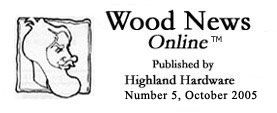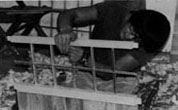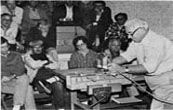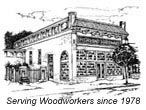|
|
The following article was originally published
in
Wood News
No. 22, Winter 1989.
Instant Gratification
by Jack Warner
There
is a suspicion in the minds of some woodworkers that people who
spend most of their time at the lathe have forsaken real work in
favor of instant gratification, dallying in a world of flash and
filigree.
Let me tell you about this instant gratification business.
Sunday, 11:30 am.
Opened up a plastic trash bag resident
in the garage since two kind friends brought it to me from North
Carolina at least two months ago. The large object in it is supposed
to be a burl from a birch tree. The percussive effects in my lower
back confirm the size; it weighs at least 50 pounds. Can't tell
yet how much of it is burl; the cut face is fully oxidized and covered
with mold.
11:45 am.
Deposit wood on workbench, cut face up; prop it
to stability with scrap chunks, run the portable planer over it
a few times. The wood revealed is lovely.
Noon.
After staring at the lump of wood for 10 minutes, I
cannot decide whether to go for broke and turn the whole thing or
be cautious and slice it up into several pieces. No obvious lines
for slicing reveal themselves; it could mean considerable waste.
When in doubt, get advice.
12:15 pm.
Call my wife down to the basement, ask her what
to do. "Go for it," she says. OK. But it needs to be done right;
I am not interested in having a 50-pound lump of wood pounce upon
me. We have got to get the thing mounted as close to balance as
possible.
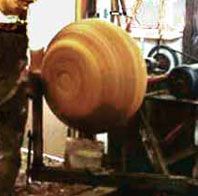
12:45 pm.
Risking hernia, I hold the bolt of wood while my
wife racks the vestigial tailstock of my bowl lathe in and out.
We test various positions; don't find the probable center until
about the fifth try. The idea is to turn off the waste and true
up the cut face, after which I'll glue it to a scrap disk on a face
plate. 1 pm. Switch on the lathe. Not too scary. It's close to being
balanced, and the lathe is wobbling only moderately.
1:20 pm.
Roughing out completed. The bolt is about 16 inches
in diameter and about a foot long. We remove it from the lathe and
glue-mount it on a faceplate with Hot Stuff.
1:30 pm.
Back on the lathe, very close to being on center,
too. With the tailstock brought in tightly, refining the shape proceeds
apace; I have no idea at this point what the shape will be. It'll
come.
1:45 pm.
It comes. The only shape this hog will take, without
sinful waste, is that of a fat, closed jar. I am not partial to
closed-vessel turning, but we won't get fancy. The opening will
be ample.
2 pm.
The outside is complete; the wood is beautiful. There
are several bark inclusions that may open up as turning proceeds.
On to the interior; there is a huge amount of wood to be wasted
out of this piece.
2:30 pm
. I've gone as far as I can with the Superflute; the
piece is opened up about 9 inches wide and down to about 2 inches
from the base, around an inch-wide column still held by the tailstock.
I want to keep the tailstock in place as long as possible; this
thing is still very heavy. Out comes the Thompson tool, made especially
for closed turning. It weighs almost 10 pounds.
3 pm.
Friends come over; I'm grateful to stop for a few minutes
and chat.
3:30 pm. Back to it; the tailstock finally has to come out Very
gingerly, now; a catch with this much weight at the perimeter could
tear it off the lathe.
4 pm.
It occurs to me that, with the increased interest in
woodtuming these days, there might be some profit in training a
couple of beavers to do this work. I mean, the important stuff,
the art part, was done in the first half an hour; the rest of it
is just trying to remove wood without ruining the thing. Thinking
about trained beavers reminds me of the greatest of the untold stories
of Sherlock Holmes, the one about the politician, the lighthouse
and the trained cormorant. The tool catches lightly; no damage,
but a warning to stop woolgathering.
5 pm.
Shovel shavings into a bag. Wife, unable to lure me
to lunch earlier, provides cookies and encouragement. Upper half
is about the right thickness. Bark inclusions are opening up at
the apogee of the curve, but the bottom half is still much too thick.
5:30 pm.
Hog that wood. Legs beginning to quiver a little;
back whining and sniveling. Getting close; don't lose it now.
6 pm.
Final scraping and smoothing. I don't think I can do
any better than this, so I stop.
6:30 pm.
Outside, and lower half of inside, sanded to 150
grit. There are all kinds of surfaces here; silky smooth to rough
bark. Upper portion of interior sanded by hand, not too well, but
I'm giving out.
7 pm.
Take it off the lathe, remove the faceplate, handsaw
off most of the scrap, sand away what's left. Not the way I usually
do it, but this piece is bigger than usual.
7:30 pm.
Sign the piece and it's done. So am I. Knees knocking,
I stagger upstairs. My wife, who will oil the fat jar over a period
of a week or two, brushes me off, cleans the chips out of my ears
and fixes me two of her extra-special hamburgers.
That's instant gratification for you.
|
|
